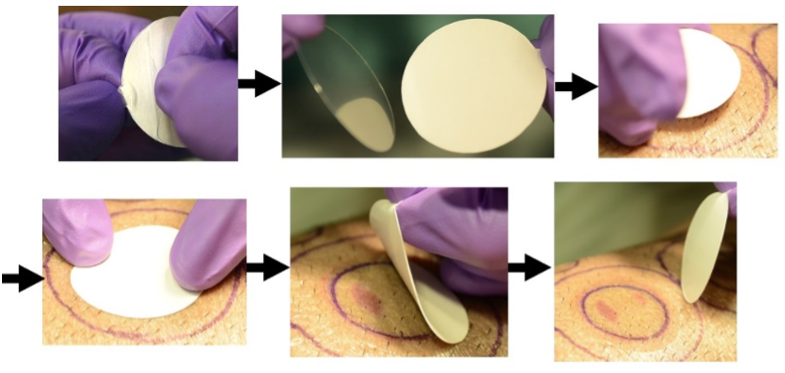Military Burn
Pirfenidone-Containing Burn Wound Patch to Reduce Scarring



Posted February 14, 2022
Kai Leung, Ph.D., United States Army Institute of Surgical Research

Burn wound scars result from a complex physiologic process. After healing from a severe burn wound, the damaged skin often forms hypertrophic scars, marked by raised, itchy and inelastic skin, dark red- or purple-colored tissue, and hypersensitivity. Hypertrophic scars originate from excessive skin fibrosis and disordered layers of skin proteins, and areas of severe scars can develop into contractures, which decrease joint mobility and contribute to chronic muscle and joint pain. Burn survivors may also feel self-conscious about severe scarring, especially facial scarring, and this can greatly reduce quality of life following an injury. For Service Members who suffer burn injuries, timely treatment of wounds to minimize or prevent scarring can be even more challenging in a prolonged field care environment with delayed access to a higher level of care. Burn-injured Service Members are also more likely to suffer severe burns than the general population, due to the nature of explosions during combat.1 This can translate to larger total body surface area burn injuries with increased burn thickness and therefore higher risk for extensive hypertrophic scarring and contractures.

Figure 1: Application of the pirfenidone-containing burn wound patch to reduce dermal fibrosis (i.e., scarring) after deep partial-thickness burns in a preclinical animal model. The patch is applied by first removing the clear release liner, exposing the silicone side of the patch, which is then placed directly onto the wound. The paper liner is then removed, leaving behind the transparent patch that adheres to the wound.
With an FY15 Military Burn Research Program (MBRP) Broad Agency Announcement for Extramural Medical Research, Dr. Kai Leung led a team of investigators at the U.S. Army Institute of Surgical Research through the development of an easily applied, drug-eluding burn wound patch as shown in the illustrations. The patch holds the drug pirfenidone, which is an anti-inflammatory and anti-fibrosis drug that is FDA-approved for the treatment of idiopathic pulmonary fibrosis. Experiments using profibrotic human dermal fibroblasts (produced by stimulation with Transforming Growth Factor Beta) demonstrated that direct contact of pirfenidone with these profibrotic fibroblasts significantly inhibited their proliferation and transformation into myofibroblasts in vitro. Increase in fibroblasts proliferation and their transformation into myofibroblasts are some of the key hallmarks of fibrosis. Excess myofibroblasts can also cause increased collagen accumulation and tissue contractures.
Investigators are testing the effectiveness of the pirfenidone burn wound patch as an early treatment to reduce dermal fibrosis (i.e., scarring) following deep partial-thickness burns in a preclinical animal model. As illustrated in the photographs, application begins with the removal of the clear release liner, exposing the silicone face of the patch, which is placed directly onto the wound. The paper liner is then removed, leaving behind the transparent patch adhering to the contours of the burn wound. The patch is stable at room temperature, can be easily carried, self-administered, and kept in place on the wound for 2 days before the next dressing change, thus allowing for use in a prolonged field care setting.
The MBRP-funded development of this pirfenidone-containing burn wound patch targets several critical gaps in burn care, including treatment options suitable for prolonged field care and improved quality of life following recovery from a burn injury through reduced hypertrophic scarring.
References:
1 Kauver DS, Cancio LC, Wolf SE, et al. 2006. Comparison of combat and non-combat burns from ongoing US military operations. Journal of Surgical Research 132:195-200.
Publications:
Chung E, Wells A, Kiamco MM, and Leung K. 2020. Dual asymmetric centrifugation efficiently produces a poloxamer-based nanoemulsion gel for topical delivery of pirfenidone. AAPS PharmSciTech 21(7):265. doi: 10.1208/s12249-020-01798-7.
PMID: 33006045.
Evani SJ, Rajasekhar Karna SL, Seshu J, and Leung KP. 2020. Pirfenidone regulates LPS mediated activation of neutrophils. Scientific Reports 10(1):19936.
doi: 10.1038/s41598-020-76271-3. PMID: 33203891.
Wells AR and Leung KP. 2020. Pirfenidone attenuates the profibrotic contractile phenotype of human dermal myofibroblasts. Biochemical and Biophysical Research Communications 521(3):646-651. doi: 10.1016/j.bbrc.2019.10.177. PMID: 31679692
Medina JL, Sebastian EA, Fourcaudot AB, et al. 2019. Pirfenidone ointment modulates the burn wound bed in C57BL/6 mice by suppressing inflammatory responses. Inflammation 42(1):45-53. doi: 10.1007/s10753-018-0871-y.
Dorati R, Medina JL, DeLuca PP, and Leung KP. 2018. Development of a topical 48-H release formulation as an anti-scarring treatment for deep partial-thickness burns. AAPS PharmSciTech 19(5):2264-2275. doi: 10.1208/s12249-018-1030-3. PMID: 29790019.
Hall CL, Wells AR, and Leung KP. 2018. Pirfenidone reduces profibrotic responses in human dermal myofibroblasts, in vitro. Laboratory Investigation 98(5):640-655.
doi: 10.1038/s41374-017-0014-3. PMID: 29497173.
Links:
Public and Technical Abstracts: Anti-Scar Treatment for Deep Partial-Thickness Burn Wounds
Last updated Thursday, December 5, 2024














